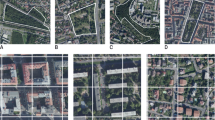Abstract
We analyze urban temperature data from mobile measurements on a late summer day in combination with land use data to identify climate effects of urban water bodies in the German city of Münster. Direct effects on urban air temperature are heterogeneous and – in the evening – rather warming than cooling, while effects of urban green spaces are clearly cooling in the afternoon and evening. Depending on the distance to the next water body, cooling effects of urban green spaces are clearly intensifying, which can be interpreted as a result of better water supply of urban green.
Access this chapter
Tax calculation will be finalised at checkout
Purchases are for personal use only
Similar content being viewed by others
References
IPCC Intergovernmental Panel on Climate Change, Climate Change 2007: Synthesis Report, Report (2007)
Oke, T.R., Mills, G., Christen, A., Voogt, J.A.: Urban Clim. (2017). https://doi.org/10.1017/9781139016476
Stewart, I.D., Oke, T.R.: Local climate zones for urban temperature studies. Bull. Amer. Meteor. Soc. 93(12), 1879–1900 (2012). https://doi.org/10.1175/BAMS-D-11-00019.1
Goldbach, A., Kuttler, W.: Quantification of turbulent heat fluxes for adaptation strategies within urban planning. Int. J. Climatol. 33, 143–159 (2013). https://doi.org/10.1002/joc.3437
Sun, R., Chen, L.-D.: How can urban bodies be designed for climate adaptation? Landsc. Urban Plan. 105(1–2), 27–33 (2012). https://doi.org/10.1016/j.landurbplan.2011.11.018
Yang, B., Meng, F., Ke, X., Ma, C., The impact analysis of water body landscape pattern on urban heat Island: a case study of Wuhan City. Adv. Meteorol. vol. 2015, Article ID 416728. http://dx.doi.org/10.1155/2015/416728
Cosgrove, A., Berkelhammer, M.: Downwind footprint of an urban heat island on air and lake temperatures. Clim. Atmos. Sci. 1, 46 (2018). https://doi.org/10.1038/s41612-018-0055-3
Gober, P., Brazel, A., Quay, R., Myint, S., Grossman-Clarke, S., Miller, A., Rossi, S.: Using watered landscapes to manipulate urban heat Island effects: how much water will it take to cool phoenix? J. Am. Plan. Assoc. 76(1), 109–121 (2009). https://doi.org/10.1080/01944360903433113
O’Malley, C., Piroozfarb, P.A.E., Farr, E.R.P., Gates, J., An investigation into minimizing urban heat island (UHI) effects: a UK perspective. Energy Procedia 62, 72–80 (2014). https://doi.org/10.1016/j.egypro.2014.12.368. 6th International Conference on Sustainability in Energy and Buildings, SEB-14
Gunawardena, K.R., Wells, M.J., Kershawa, T.: Utilising green and bluespace to mitigate urban heat island intensity. Sci. Tot. Environ. 584–585, 1040–1055 (2017). https://doi.org/10.1016/j.scitotenv.2017.01.158
Wu, Z., Zhang, Y.: Water bodies’ cooling effects on urban land daytime surface temperature: ecosystem service reducing heat Island effect. Sustainability (2019). https://doi.org/10.3390/su11030787
Frerichs, S., Kranefeld, A., Noky, B., Oligschläger, M., Simon, A., Ketzler, G., Petzoldt, K., Schneider, C.: Klimaanpassungskonzept stadt Münster = climate adaptation concept city of Münster. Report Number: RWTH-2020-05680 (2015)
Seidel, J., Ketzler, G., Bechtel, B., Thies, B., Philipp, A., Boehner, J., Egli, S., Eisele, M., Herma, F., Langkamp; T., Petersen, E., Sachsen, T., Schlabing, D., Schneider, C.: Mobile measurement techniques for local and micro-scale studies in urban and topoclimatology. Die Erde 147(1), 15–39 (2016). https://doi.org/10.12854/erde.v147i1.257
Buttstädt, M., Schneider, C.: Thermal load in a medium-sized european city using the example of Aachen,Germany. Erdkunde 68(2), 71–83 (2014). https://doi.org/10.3112/erdkunde.2014.02.01
GEObasis.nrw: Geobasisdaten Vermessungs- und Katasterverwaltung NRW = Geobasisdata Landsurvey and Cadastral Administration North Rhine-Westphalia. http://www.tim-online.nrw.de. Accessed 17 Oct 2013
Mahrt, L.: The near‐surface evening transition, Q.J.R. Meteorol. Soc. 143, 2940–2948. https://doi.org/10.1002/qj.3153
Oke, T.R., Crowther, J.M., McNaughton, K.G., Monteith, J.L., Gardiner, B., The micrometeorology of the urban forest [and discussion]. Philos. Trans. Roy. Soc. Lond. Ser. B Biol. Sci. 324(1223) Forest, Weather and Climate, 335–349 (1989). http://links.jstor.org/sici?sici=0080-4622%2819890831%29324%3A1223%3C335%3ATMOTUF%3E2.0.CO%3B2-9
Acknowledgments
The Climate Adaptation Concept for the City of Münster was funded by the German Ministry of Environment, Nature Protection and Nuclear Safety as part of the National Climate Protection Initiative 2015, funding number 03KS7649. The development of the Urbmobi temperature sensor used in this study was funded by the EIT Climate-KIC funding of the European Union, 2013 (“Urban Mobile Instruments for Environmental Monitoring”).
Thanks to the anonymous reviewer for helpful advice.
Author information
Authors and Affiliations
Corresponding author
Editor information
Editors and Affiliations
Rights and permissions
Copyright information
© 2021 The Author(s), under exclusive license to Springer Nature Switzerland AG
About this paper
Cite this paper
Ketzler, G., Goertz, S., Leuchner, M. (2021). Effects of Small Water Bodies on the Urban Heat Island and Their Interaction with Urban Green Spaces in a Medium-Size City in Germany. In: Vasenev, V., et al. Advanced Technologies for Sustainable Development of Urban Green Infrastructure. SSC 2020. Springer Geography. Springer, Cham. https://doi.org/10.1007/978-3-030-75285-9_7
Download citation
DOI: https://doi.org/10.1007/978-3-030-75285-9_7
Published:
Publisher Name: Springer, Cham
Print ISBN: 978-3-030-75284-2
Online ISBN: 978-3-030-75285-9
eBook Packages: Earth and Environmental ScienceEarth and Environmental Science (R0)




